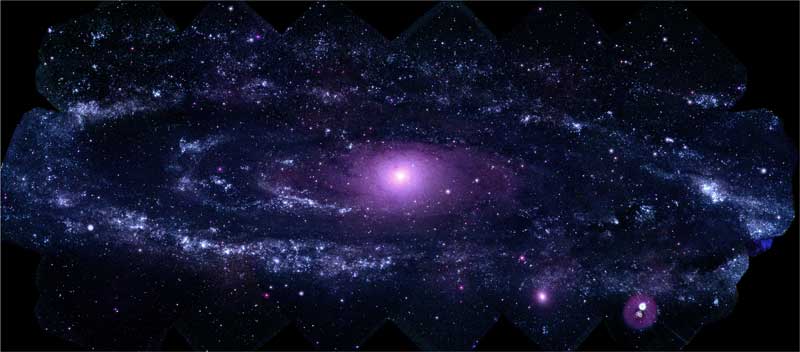Best UV View Ever of Andromeda Galaxy

Anew view of the Andromeda Galaxy reveals hot, young stars in ultraviolet light.
NASA'sSwift satellite acquired the highest-resolution view of a neighboring spiralgalaxy ever attained in the ultraviolet, according to NASA. The galaxy, knownas M31 in the constellation Andromeda, is the largest and closest spiral galaxyto our own.
"Swiftreveals about 20,000 ultraviolet sources in M31, especially hot, young starsand dense star clusters," said Stefan Immler, a research scientist on theSwift team at NASA's Goddard Space Flight Center. "Of particularimportance is that we have covered the galaxy in three ultraviolet filters.That will let us study M31's star-formation processes in much greater detailthan previously possible."
TheAndromedaGalaxy, is more than 220,000 light-years across and lies 2.5 millionlight-years away. On a clear, dark night, the galaxy is faintly visible as amisty patch to the naked eye.
Andromedaand our own Milky Way Galaxy are expectedto collide in a few billion years.
Thenew image, released this week, were made from 330 observations done last yearduring a total of 24 hours of observing time.
Thetask of assembling the resulting 85 gigabytes of images fell to Erin Grand, anundergraduate student at the University of Maryland at College Park who workedwith Immler as an intern this summer. "After ten weeks of processing thatimmense amount of data, I'm extremely proud of this new view of M31," shesaid.
Get the Space.com Newsletter
Breaking space news, the latest updates on rocket launches, skywatching events and more!
Severalfeatures are immediately apparent in the new mosaic. The first is the strikingdifference between the galaxy's central bulge and its spiral arms. "Thebulge is smoother and redder because it's full of older and cooler stars,"Immler explained. "Very few new stars form here because most of the materialsneeded to make them have been depleted."
Denseclusters of hot, young, blue stars sparkle beyond the central bulge. As in ourown galaxy, M31's disk and spiral arms contain most of the gas and dustneeded to produce new generations of stars. Star clusters are especiallyplentiful in an enormous ring about 150,000 light-years across.
Whattriggers the unusually intense star formation in Andromeda's "ringof fire"? Previous studies have shown that tides raised by the manysmall satellite galaxies in orbit around M31 help boost the interactions withingas clouds that result in new stars.
In1885, an exploding star in M31's central bulge became bright enough to see withthe naked eye. This was the first supernova ever recorded in any galaxy beyondour own Milky Way.
"Weexpect an average of about one supernova per century in galaxies likeM31," Immler said. "Perhaps we won't have to wait too long foranother one."
- Video: Galaxy Collisions
- Image Gallery: Amazing Galaxies
- Andromeda Galaxy: Best of Your Images
Join our Space Forums to keep talking space on the latest missions, night sky and more! And if you have a news tip, correction or comment, let us know at: community@space.com.

Space.com is the premier source of space exploration, innovation and astronomy news, chronicling (and celebrating) humanity's ongoing expansion across the final frontier. Originally founded in 1999, Space.com is, and always has been, the passion of writers and editors who are space fans and also trained journalists. Our current news team consists of Editor-in-Chief Tariq Malik; Editor Hanneke Weitering, Senior Space Writer Mike Wall; Senior Writer Meghan Bartels; Senior Writer Chelsea Gohd, Senior Writer Tereza Pultarova and Staff Writer Alexander Cox, focusing on e-commerce. Senior Producer Steve Spaleta oversees our space videos, with Diana Whitcroft as our Social Media Editor.









